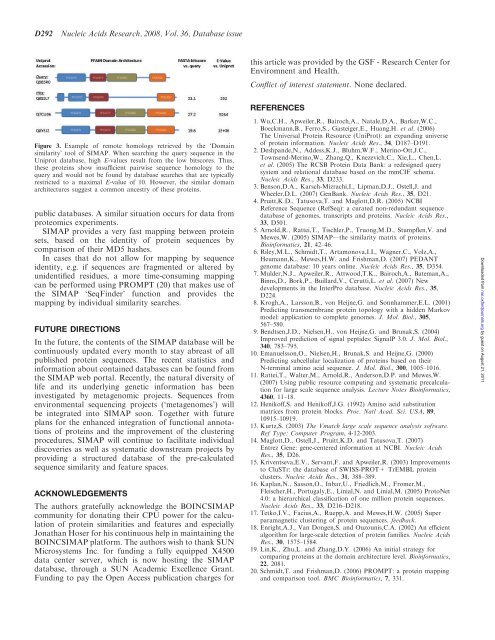SIMAPâstructuring the network of protein similarities
SIMAPâstructuring the network of protein similarities
SIMAPâstructuring the network of protein similarities
Create successful ePaper yourself
Turn your PDF publications into a flip-book with our unique Google optimized e-Paper software.
D292<br />
Nucleic Acids Research, 2008, Vol. 36, Database issue<br />
this article was provided by <strong>the</strong> GSF - Research Center for<br />
Enviromnent and Health.<br />
Conflict <strong>of</strong> interest statement. None declared.<br />
Figure 3. Example <strong>of</strong> remote homologs retrieved by <strong>the</strong> ‘Domain<br />
similarity’ tool <strong>of</strong> SIMAP. When searching <strong>the</strong> query sequence in <strong>the</strong><br />
Uniprot database, high E-values result from <strong>the</strong> low bitscores. Thus,<br />
<strong>the</strong>se <strong>protein</strong>s show insufficient pairwise sequence homology to <strong>the</strong><br />
query and would not be found by database searches that are typically<br />
restricted to a maximal E-value <strong>of</strong> 10. However, <strong>the</strong> similar domain<br />
architectures suggest a common ancestry <strong>of</strong> <strong>the</strong>se <strong>protein</strong>s.<br />
public databases. A similar situation occurs for data from<br />
proteomics experiments.<br />
SIMAP provides a very fast mapping between <strong>protein</strong><br />
sets, based on <strong>the</strong> identity <strong>of</strong> <strong>protein</strong> sequences by<br />
comparison <strong>of</strong> <strong>the</strong>ir MD5 hashes.<br />
In cases that do not allow for mapping by sequence<br />
identity, e.g. if sequences are fragmented or altered by<br />
unidentified residues, a more time-consuming mapping<br />
can be performed using PROMPT (20) that makes use <strong>of</strong><br />
<strong>the</strong> SIMAP ‘SeqFinder’ function and provides <strong>the</strong><br />
mapping by individual similarity searches.<br />
FUTURE DIRECTIONS<br />
In <strong>the</strong> future, <strong>the</strong> contents <strong>of</strong> <strong>the</strong> SIMAP database will be<br />
continuously updated every month to stay abreast <strong>of</strong> all<br />
published <strong>protein</strong> sequences. The recent statistics and<br />
information about contained databases can be found from<br />
<strong>the</strong> SIMAP web portal. Recently, <strong>the</strong> natural diversity <strong>of</strong><br />
life and its underlying genetic information has been<br />
investigated by metagenomic projects. Sequences from<br />
environmental sequencing projects (‘metagenomes’) will<br />
be integrated into SIMAP soon. Toge<strong>the</strong>r with future<br />
plans for <strong>the</strong> enhanced integration <strong>of</strong> functional annotations<br />
<strong>of</strong> <strong>protein</strong>s and <strong>the</strong> improvement <strong>of</strong> <strong>the</strong> clustering<br />
procedures, SIMAP will continue to facilitate individual<br />
discoveries as well as systematic downstream projects by<br />
providing a structured database <strong>of</strong> <strong>the</strong> pre-calculated<br />
sequence similarity and feature spaces.<br />
ACKNOWLEDGEMENTS<br />
The authors gratefully acknowledge <strong>the</strong> BOINCSIMAP<br />
community for donating <strong>the</strong>ir CPU power for <strong>the</strong> calculation<br />
<strong>of</strong> <strong>protein</strong> <strong>similarities</strong> and features and especially<br />
Jonathan Hoser for his continuous help in maintaining <strong>the</strong><br />
BOINCSIMAP platform. The authors wish to thank SUN<br />
Microsystems Inc. for funding a fully equipped X4500<br />
data center server, which is now hosting <strong>the</strong> SIMAP<br />
database, through a SUN Academic Excellence Grant.<br />
Funding to pay <strong>the</strong> Open Access publication charges for<br />
REFERENCES<br />
1. Wu,C.H., Apweiler,R., Bairoch,A., Natale,D.A., Barker,W.C.,<br />
Boeckmann,B., Ferro,S., Gasteiger,E., Huang,H. et al. (2006)<br />
The Universal Protein Resource (UniProt): an expanding universe<br />
<strong>of</strong> <strong>protein</strong> information. Nucleic Acids Res., 34, D187–D191.<br />
2. Deshpande,N., Addess,K.J., Bluhm,W.F., Merino-Ott,J.C.,<br />
Townsend-Merino,W., Zhang,Q., Knezevich,C., Xie,L., Chen,L.<br />
et al. (2005) The RCSB Protein Data Bank: a redesigned query<br />
system and relational database based on <strong>the</strong> mmCIF schema.<br />
Nucleic Acids Res., 33, D233.<br />
3. Benson,D.A., Karsch-Mizrachi,I., Lipman,D.J., Ostell,J. and<br />
Wheeler,D.L. (2007) GenBank. Nucleic Acids Res., 35, D21.<br />
4. Pruitt,K.D., Tatusova,T. and Maglott,D.R. (2005) NCBI<br />
Reference Sequence (RefSeq): a curated non-redundant sequence<br />
database <strong>of</strong> genomes, transcripts and <strong>protein</strong>s. Nucleic Acids Res.,<br />
33, D501.<br />
5. Arnold,R., Rattei,T., Tischler,P., Truong,M.D., Stumpflen,V. and<br />
Mewes,W. (2005) SIMAP—<strong>the</strong> similarity matrix <strong>of</strong> <strong>protein</strong>s.<br />
Bioinformatics, 21, 42–46.<br />
6. Riley,M.L., Schmidt,T., Artamonova,I.I., Wagner,C., Volz,A.,<br />
Heumann,K., Mewes,H.W. and Frishman,D. (2007) PEDANT<br />
genome database: 10 years online. Nucleic Acids Res., 35, D354.<br />
7. Mulder,N.J., Apweiler,R., Attwood,T.K., Bairoch,A., Bateman,A.,<br />
Binns,D., Bork,P., Buillard,V., Cerutti,L. et al. (2007) New<br />
developments in <strong>the</strong> InterPro database. Nucleic Acids Res., 35,<br />
D224.<br />
8. Krogh,A., Larsson,B., von Heijne,G. and Sonnhammer,E.L. (2001)<br />
Predicting transmembrane <strong>protein</strong> topology with a hidden Markov<br />
model: application to complete genomes. J. Mol. Biol., 305,<br />
567–580.<br />
9. Bendtsen,J.D., Nielsen,H., von Heijne,G. and Brunak,S. (2004)<br />
Improved prediction <strong>of</strong> signal peptides: SignalP 3.0. J. Mol. Biol.,<br />
340, 783–795.<br />
10. Emanuelsson,O., Nielsen,H., Brunak,S. and Heijne,G. (2000)<br />
Predicting subcellular localization <strong>of</strong> <strong>protein</strong>s based on <strong>the</strong>ir<br />
N-terminal amino acid sequence. J. Mol. Biol., 300, 1005–1016.<br />
11. Rattei,T., Walter,M., Arnold,R., Anderson,D.P. and Mewes,W.<br />
(2007) Using public resource computing and systematic precalculation<br />
for large scale sequence analysis. Lecture Notes Bioinformatics,<br />
4360, 11–18.<br />
12. Henik<strong>of</strong>f,S. and Henik<strong>of</strong>f,J.G. (1992) Amino acid substitution<br />
matrices from <strong>protein</strong> blocks. Proc. Natl Acad. Sci. USA, 89,<br />
10915–10919.<br />
13. Kurtz,S. (2003) The Vmatch large scale sequence analysis s<strong>of</strong>tware.<br />
Ref Type: Computer Program, 4-12-2003.<br />
14. Maglott,D., Ostell,J., Pruitt,K.D. and Tatusova,T. (2007)<br />
Entrez Gene: gene-centered information at NCBI. Nucleic Acids<br />
Res., 35, D26.<br />
15. Kriventseva,E.V., Servant,F. and Apweiler,R. (2003) Improvements<br />
to CluSTr: <strong>the</strong> database <strong>of</strong> SWISS-PROT+ TrEMBL <strong>protein</strong><br />
clusters. Nucleic Acids Res., 31, 388–389.<br />
16. Kaplan,N., Sasson,O., Inbar,U., Friedlich,M., Fromer,M.,<br />
Fleischer,H., Portugaly,E., Linial,N. and Linial,M. (2005) ProtoNet<br />
4.0: a hierarchical classification <strong>of</strong> one million <strong>protein</strong> sequences.<br />
Nucleic Acids Res., 33, D216–D218.<br />
17. Tetko,I.V., Facius,A., Ruepp,A. and Mewes,H.W. (2005) Super<br />
paramagnetic clustering <strong>of</strong> <strong>protein</strong> sequences. feedback.<br />
18. Enright,A.J., Van Dongen,S. and Ouzounis,C.A. (2002) An efficient<br />
algorithm for large-scale detection <strong>of</strong> <strong>protein</strong> families. Nucleic Acids<br />
Res., 30, 1575–1584.<br />
19. Lin,K., Zhu,L. and Zhang,D.Y. (2006) An initial strategy for<br />
comparing <strong>protein</strong>s at <strong>the</strong> domain architecture level. Bioinformatics,<br />
22, 2081.<br />
20. Schmidt,T. and Frishman,D. (2006) PROMPT: a <strong>protein</strong> mapping<br />
and comparison tool. BMC Bioinformatics, 7, 331.<br />
Downloaded from nar.oxfordjournals.org by guest on August 21, 2011
















